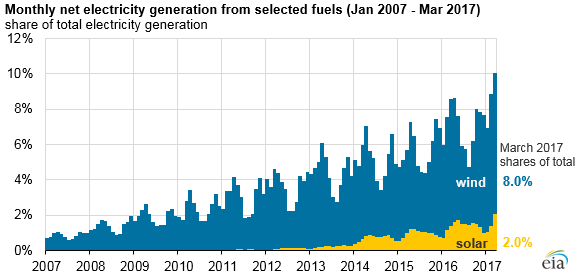In March, wind and solar generated a record 10% of US electricity
June 14, 2017

According to the Energy Information Administration’s Electric Power Monthly, a bit more than 10 percent of all electricity generated in the US in March came from wind and solar power (including both distributed residential solar panels and utility-scale solar installations). That’s a record number for the country, and it reflects continuing effort to install more renewable capacity across the nation.
The EIA shows that eight percent of total electricity generation that month came from wind, and the other two percent came from solar. The administration also predicts that wind and solar will contribute more than 10 percent of the total electricity produced in April, although numbers for that month aren’t out yet.

Renewables have tended to hit records in spring and fall—often called shoulder seasons—because wind is plentiful and the northern hemisphere receives a more even amount of sunlight during those seasons than it does during winter. In addition, electricity consumers tend to use less during the shoulder seasons (mild weather means they’re usually not running air conditioners or space heaters, for example). That means overall energy use is low and peak-demand fossil fuel-burning plants don’t need to come online. All these factors together make it easy for renewable energy to shoulder a larger and larger share of the work.
Although solar electricity generation usually increases considerably in the summer, the EIA doesn’t expect that increase to compensate for the reductions in spring and fall wind power this year.
In a separate study, GTM Research and the Energy Storage Association also found that stationary energy batteries have had a booming first quarter of 2017 as well. Batteries go hand in hand with intermittent resources like wind and solar because they can smooth out some of the times when those renewable sources can’t provide electricity.
In the first quarter of 2017, a record 234 MWh of storage appear to have been installed around the US. The surge was partially caused by a mandate from California regulators that utilities in that state install batteries after a massive methane leak prompted the shutdown of the Aliso Canyon natural gas storage facility. Tesla, AES Energy Storage, and Ice Energy all completed contracts in the first quarter of 2017 pursuant to California’s mandate.
However, the study suggested that this first quarter may be the largest for energy storage in 2017 because few additional storage projects are currently planned for later in the year.
For now, the EIA says the renewable energy number to beat is seven percent, which is the percentage of electricity that was renewably generated in the US throughout 2016. Last year, Texas accounted for the most wind on the US grid, with California trailing Texas in wind and almost making up the difference in solar.
“As a share of the state’s total electricity generation, wind and solar output was highest in Iowa, where wind and solar made up 37 percent of electricity generation in 2016,” the EIA wrote. Part of Iowa’s high percentage of renewable energy has to do with the state’s electricity needs being comparatively low. California and Hawaii are two states that have aggressive renewable goals, too. If we include geothermal, biomass, and small-scale hydroelectric power in addition to wind and solar, California sourced 27 percent of its energy from renewable sources last year, and Hawaii hit 26 percent.
Credit: Megan Geuss, Ars Technica. See the original article here.





